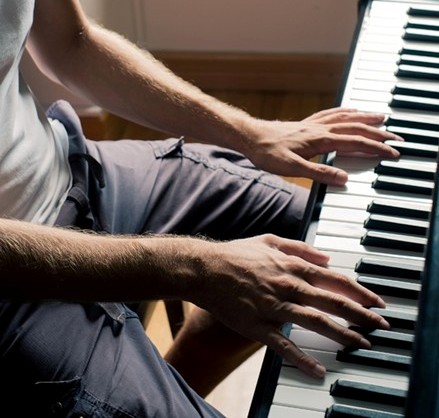There’s more people than ever before who want to know how to learn to play piano at home. In this article, I’m going to cover in detail how to approach it in a way to help you become successful the fastest way possible and in a way that will allow you to have fun doing it.
In order to learn piano at home, it is necessary to be familiar with concepts such as chords, keys of music, the number system, rhythms and melodies. It’s also necessary to make a commitment to study and practice on a daily basis.
I once heard someone say that playing the piano is the most failed at social skill in history. This statement may have been more true in times past when the piano was the centerpiece of entertainment in our homes. I still believe it still holds water today.
There’s more entertainment options now such as recorded music, movies, tv, video games, books, apps and every type of digital media that you can imagine. Add to the fact that it all exists on a mobile device you can use anywhere in the world and it would seem that anything outside of it would no longer be relevant.
But that’s quite the opposite, because you’ve probably noticed that everything we have outside of the digital world can be mimicked, showcased, augmented, highlighted and discussed within it.
This instrument known as the piano is no exception. There are books, videos, blogs, images, apps, articles, and podcasts that prove the interest in learning and playing the piano is as strong, if not stronger than it ever has been.
Music Tech and Traditional Piano Lessons
Music technology has exploded with everything else in the digital world and we no longer have only acoustic and electro-mechanical keyboard instruments. We have every type of digital keyboard you can think of in just about any size. We can thank the microprocessor for the technology that allows us to hear virtually any sound at the press of a button.
 One thing that has remained during these advancements is the methods of teaching piano. Traditional piano lessons are ubiquitous. And you just may be like myself having had them as a child and/or as an adult.
One thing that has remained during these advancements is the methods of teaching piano. Traditional piano lessons are ubiquitous. And you just may be like myself having had them as a child and/or as an adult.
If you’ve experienced them firsthand, then you know that traditional piano lessons are very much based on the precision oriented task of reading music and adhering to some very strict rules that take a respectable amount of time to master.
There’s nothing wrong with instructing a piano student to read music and rules are necessary to follow at least until you know enough in order to break them. The real issue is how much note reading and rule following does an aspiring piano player really need so they can acquire the skills to make good sounding music?
This question actually begs another one and that is: What are your musical goals? The answer really determines on how you’re going to approach how to learn to play piano at home.
Alternative/creative piano lessons are at the opposite spectrum of traditional piano lessons. I’ll cover more about those a little later. But it’s the traditional piano lessons that are among the most readily available to most people.
There’s a culture of well meaning and passionate music loving piano players who discovered long ago that careers in their chosen field are limited to teaching children and young adults the lineage of music reading and rules I discussed earlier. Why children? Aren’t adults just as capable of acquiring a formal music education? Well, I don’t want to answer the question with a yes or no because it depends on more than just one factor.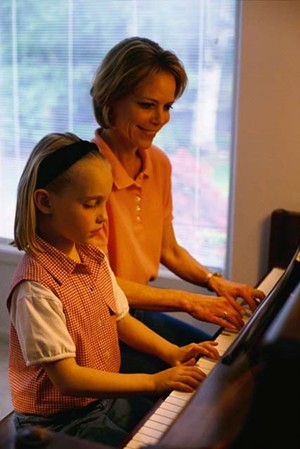
If you’ve had piano lessons in the past and you’re starting again, you’re more likely to have a sense of music with the skills you’ve already obtained.
However, if you’ve never really reached an intermediate level of piano skills, it’s most likely that you’ll feel as though you’re staring from scratch.
But you need to know that traditional piano lessons always have been designed for the classical music repertoire. Most classical music isn’t intended to be improvised on and freely interpreted.
You’re expected to play those pieces in the style of the time period and that means playing them as written note for note. It’s a very tedious process filled with method books, exercises and rules about music theory.
As far as children and young adults are concerned, traditional piano lessons make sense because students have a greater capacity to learn music than adults because they’re still developing and also have the time.
By time, I’m talking about several years of piano lessons. Work and family commitments are not going to get in the way as with most adults. Plus Mom and Dad are paying for the lessons, so what’s lacking in self discipline will definitely be met with enforcement.
Adults are at a disadvantage in the traditional piano lesson process. The time and technique possibilities diminish as you get older. This leads to a lot frustration and eventually procrastination that results in quitting piano lessons. Even children experience this but if parents persist, they have no choice but follow through and stay with it.
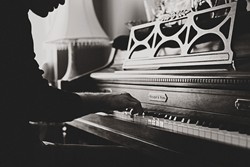 There’s actually good news for piano quitters and even those that never began in the first place. Remember the goals that I touched on earlier? It turns out that most aspiring adult piano players aren’t passionate or even have the desire to play classical music.
There’s actually good news for piano quitters and even those that never began in the first place. Remember the goals that I touched on earlier? It turns out that most aspiring adult piano players aren’t passionate or even have the desire to play classical music.
You very well may be one of them. Now I’m not saying that they wouldn’t want to play fur Elise or Pachelbel’s Canon in D. These are among the more well known pieces of classical music that most people are familiar with. I’m stating as a whole, most aspiring piano players wish to play popular music.
This is the style of music that you grew up with, listening to on the radio. It’s modern, contemporary and we’ve been listening to it most of our lives.
My Experience With Piano Lessons
This was my goal as a child piano student. I didn’t know how to express that it was the kind of music that I wanted to play. All that I really knew was that I was being told what to do and what to practice. I didn’t feel as though as I was playing music.
I felt as though I was pushing buttons to produce the correct sounds and by doing it enough, I would someday possess the ability to play what sounded like real music. I wasn’t a prodigy or even a gifted piano student. It took a lot of work just to be able play the basic sounding songs that was assigned to me.
These lessons went on for three years as a child until I was so uninspired that I conveniently stopped taking my 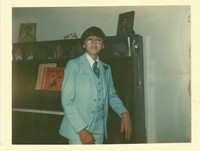 piano books to school (my lessons were during school hours as part of a community school program).
piano books to school (my lessons were during school hours as part of a community school program).
When my Dad found out that he was paying for piano lessons for a kid that wasn’t even interested enough to bring his books to, he became furious one afternoon and literally ripped my piano books in half (yes it really happened) and ordered me to go to school the next day and inform my piano teacher that I was quitting.
I was humiliated and embarrassed. What’s even more was that I was ashamed and felt like a quitter. The feeling was warranted because I was a quitter. My Dad just nudged me in the right direction. I didn’t touch a piano again until I became an adult.
Fast forward to the age of around 30 years old. I wanted another crack at it. I felt as an adult, I would be more focused and committed to learn how to play the piano with traditional piano lessons. So I found a piano teacher and got started (nearly where I left off).
This time around, I did voice my goals to my piano teacher about wanting to play popular as well as jazz influenced music. She very considerately found some method books that were oriented around the styles of music that I wanted to play. Off I was to rediscover my love of playing the piano which I never lost my fascination for.
Unfortunately, it wasn’t long until I started remembering just what caused me to want to quit piano lessons in the first place.
Here was the problem: Even though my goal was to play popular/contemporary instead of classical music, the method was still the same. It was still all about reading music and adhering to the rules of traditional piano instruction. After another three years, I found myself frustrated and not motivated to continue on.
I didn’t enroll in the next semester of the performing arts center where I had been taking lessons. I decided to go my own way and find out how to learn to play piano at home instead of traditional lessons with a teacher. I now know it’s the best decision I ever made concerning my life as a musician.
Moving on from piano lessons
I began to seek out creative methods to learn and found a lot of those resources online. By learning on my own from so many different resources I discovered there were a lot of myths about learning how to play the piano that I was never aware of as a traditional student. Here’s what they are:
1. You have to start taking lessons as a child. False. There are many thousands of people of all ages that start learning how to play the piano as adults and do very well at it. You still have the same capacity as an adult to learn to play the songs you’ve always wanted to play.
2. You must take lessons from a teacher. False. A motivated student with the right direction is far better than a having a teacher that is teaching them rules upon rules and boring exercises that doesn’t make any sense to them.
3. You must learn to be able to read music very well. False. Some of the greatest musicians out there actually can not read music at all. They learned how to play from patterns and chord charts. Many musicians use lead sheets which are an abbreviated form reading music that far easier than traditional music reading.
4. You have to know all about music theory. False. You don’t have to become a professor with a master’s degree in music in order play the piano and sound good. All you need to know are the mechanics of music and not worry about diving into music theory up to your eyeballs. If you don’t know every rule about music theory, it’s not going to break you as a piano player. It’s about how your music sounds at the keyboard.
Ok, so what did I discover that was contrary to traditional piano lessons that help me learn how to play piano at home?
How to learn to play piano at home: What you really need to know
First of all, playing piano isn’t about playing notes. This is one of the aspects of piano playing that was causing me a lot of frustration. I was trying to read and play every note on the page and it was overwhelming me. I then discovered the concept of chords.
When you’re playing a group of notes in unison, they belong to a family. This makes life a whole lot easier because you’re now identifying members of a familiar group instead of just random notes.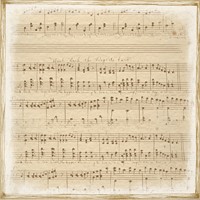
I also started looking at scales much differently than I had in the past. I read a sentence in a book that changed my life. It simply stated: “Scales are the raw materials for chords”.
Learning those seven different note patterns took on a new meaning so much that I quickly learned all of them because they had a new purpose and a new meaning.
I later discovered that the number system is everything. Every chord has a number assigned to it and those chords are built upon numbers. They don’t teach this stuff with traditional piano lessons. It’s very liberating with you grasp this concept.
Taking what I’ve just mentioned into consideration, it led me into being able to use standard sheet music as a guide instead of something that dictates to me every note that I must play. I didn’t have to play all of those notes and could change anything I wish and it wasn’t going to break the piece of music I was playing.
I discovered sheet music to many of the popular songs I wanted to play was transcribed by an arranger (a person who listens to the song and puts the notes on paper) and many songs are not note for note transcriptions. They’re just representations to help you play a different version of the song than what you hear on a recording of it.
After all, most of the music you hear isn’t solo piano. It’s a multi-instrumental version that was assembled in a recording 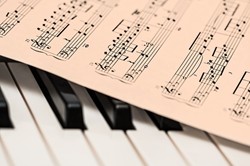 studio and polished to perfection. You won’t get that sound from playing the song on your piano. But it’s not intended to.
studio and polished to perfection. You won’t get that sound from playing the song on your piano. But it’s not intended to.
I also discovered that many sheet music arrangements of songs are disappointing to play note for note. Why? I can give you two reasons:
1. Most of them are at an intermediate level of sight reading or below. They can’t be too advanced because publishers wouldn’t sell many of them. They have to keep them at a level your average piano player is able to read. If you play many of them note for note, they don’t sound like the songs that you and I know and love.
2. Because an arranger transcribed the song, they may have not listened to the song anywhere near as many times as you have. That special chord or hook that you’re used to hearing may not even exist in the sheet music. Having learned what I just shared with you allowed me to use lead sheets and sheet music as a guide because the melody line and chord symbols are a good outline for the song.
Plus there’s no reason I can’t utilize the written bass notes when it makes sense. But just know this: I never play anything as it’s written note for note and in the end I play the song how I want to. I play it the way it sounds good to me.
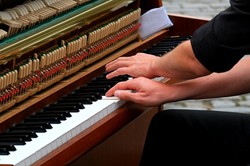 If you want to know how to learn to play piano at home, here’s the way to approach it:
If you want to know how to learn to play piano at home, here’s the way to approach it:
Don’t start trying to learn with method books that traditional piano teachers use. It’s okay for kids to crawl before they can walk but not adults. You’re not a child so the approach must be different.
If you don’t know the notes on the piano, learn them. You can learn them in one afternoon. Please do not use stickers or write note names on the keys. This becomes a crutch that’s hard to get rid of.
Learn useful concepts such as the 12 Major chords before diving into traditional music theory
This means do not start out trying to learn to read music. Don’t try to learn your scales as your piano teacher (assuming you had one) instructed you to do. There will be a time to start learning these aspects of music as you teach yourself how to learn to play piano at home, but starting out with them is a mistake.
I know that what I’ve just suggested that you do is contrary to any traditional piano instructor’s advice, but there is a reason to avoid trying to learn these things in the beginning. One of those reasons being, is that they won’t have any musical context for you if you’re not using them to make music.
reason to avoid trying to learn these things in the beginning. One of those reasons being, is that they won’t have any musical context for you if you’re not using them to make music.
It’s like a motorcycle enthusiast who buys all of the accessories and gear he’s going to need, but he doesn’t have money for the motorcycle yet. He’s going to need those items but they’re no use to him until then.
When you’re learning something that has no context (even temporarily) it won’t keep you engaged in that activity. In this case, those technical building blocks of music are just that.
You need something that you can use and you’ll find that the 12 Major chords are very useful. You’ll make real music and have fun. Isn’t that why all of us want to play music in the first place?
Again, I’ll reiterate that most traditional piano teachers don’t follow the path of instruction that I’ve just covered. Many of them have piano pedagogy (the study of teaching) credentials that is by nature long and drawn out over several years.
Those that follow this path, gain a general skill in music that’s really oriented towards academic music studies. That’s why young children make up the majority of piano students. Most of them quit taking lessons before their teen years and move onto something else.
What keeps the traditional piano instructors in business, is a fresh new generation of children who cross the age 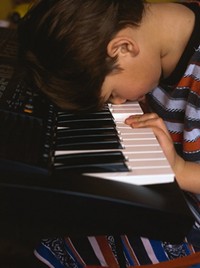 threshold every year and the small percentage of students that remain.
threshold every year and the small percentage of students that remain.
This is why adults who take piano lessons are such a small minority. They do if for many reasons. One that I can attest to is feeling the need to fulfill a dream they had as a child, but unfortunately became part of the majority who quit taking piano lessons before they became an adult.
We have such an advantage over past generations because we live in a 21st century digital world. Knowledge and skills are available to anyone who is willing to seek them. Information can hide from no one.
That’s why there has never been a better time in history for someone who wants to know how to learn to play piano at home. Some of the best musicians in history are self taught. This doesn’t imply that you’re to just blindly go at it and learn from trial and error. The knowledge you need is available to you without having to do that.
So how do you approach how to learn to play the piano at home and what are the best ways to learn creatively?
 One very popular piano learning strategy is learning to play piano by ear. Unless, you’ve been in a cave, you must have seen or read about play by ear instruction. Learning to play the piano by ear is certainly a valid approach.
One very popular piano learning strategy is learning to play piano by ear. Unless, you’ve been in a cave, you must have seen or read about play by ear instruction. Learning to play the piano by ear is certainly a valid approach.
But there’s a misnomer about learning to play by ear that is not discussed. The “by ear” approach implies that the instruction is all about hearing something and playing it without other musical factors coming into play.
But play by ear instructors start out by teaching the fundamentals of what I just covered (notes on the keyboard, chords, intervals, etc.) The ear aspect of playing piano doesn’t come into focus until one learns those things that I mentioned.
It’s only then that you start to recognize chord progressions, chord patterns, bass lines, etc. This skill is best pursued after you have a grasp of music theory and keyboard playing.
Some aspiring piano players also associate the play by ear approach with learning how to recognize musical pitches (called perfect or absolute pitch). However, most people who possess this skill are born with it. The skill of relative pitch (recognizing intervals) is one that’s more commonly taught and trained in.
How to learn to play piano at home consists of three aspects of study. Here’s how I refer to them:
The Three Legs of The Stool Of Learning To Play Piano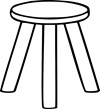
1. The Intellectual
The intellectual leg of the stool refers to facts about piano playing such as how many notes there are in music, the pattern of a Major scale, what the intervals are in a chord, etc. These are simply facts that you understand on a cognitive level.
2. The Aural
The aural leg refers to your sense of hearing. This isn’t necessarily play by ear which I covered earlier, but would tie into it. What the aural leg refers to is hearing what your playing and recognizing the variations of the sounds. If you play a Major chord, it will sound one way, a minor chord sounds different, a diminished chord will sound more different than both of these. One of the most important aspects of the aural leg is hearing when you play a wrong note. This comes very naturally and your ears are a lot smarter than you realize.
3. The kinesthetic
The kinesthetic leg is one in which most piano instructors don’t discuss because they’re not aware of it (at least not consciously). This is probably the most fascinating aspect of piano playing because of how it relates to everything else that we physically do.
 A good example of kinesthetic sense can be taught to us by a mouse. (you read that correctly) Mice seek to find food sources in a familiar environment so they can easily commute. But they’re not able to do it very well visually.
A good example of kinesthetic sense can be taught to us by a mouse. (you read that correctly) Mice seek to find food sources in a familiar environment so they can easily commute. But they’re not able to do it very well visually.
Mice have poor vision and can’t see farther than about 20 feet in front of their face. They’re also color blind and to make things more difficult for them, they can’t see sharp images.
So how can a mouse function with these impairments? It uses a sense that detects body position, weight, and movement of the muscles, tendons, and joints to find their way to and from food sources as well as other needed amenities. This is referred to as kinesthetic sense.
Human beings don’t have an acute kinesthetic sense like a mouse. We’re not as dependent on it because we have other reliable senses to depend upon. However, we do have a certain level of kinesthetic ability.
We develop our kinesthetic ability through training and awareness of it. The developmental psychologist Howard Gardener once proposed a theory of multiple intelligences in which one was aptly entitled: kinesthetic intelligence. It’s defined as the capacity to use your whole body or parts of your body to solve a problem, make something, or put on some kind of production.
You and I use our kinesthetic intelligence every day. I’ll illustrate this by asking these questions:
Can you tie your shoes with your eyes closed? If you’re above the age of four, I would think that the answer is yes. 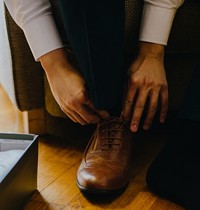 What allows you to do so if you can’t actually see what you’re doing?
What allows you to do so if you can’t actually see what you’re doing?
Did you ever learn how to drive a manual shift car? (some call it a stick shift) I’ll bet if you’re like me, you weren’t very good at it to begin with. But if you’re like most people, you became good enough at it to perform the task without even consciously paying attention to all of the physical tasks involved. (press the clutch, press the brake, start the ignition, shift gears, press the gas pedal, watch the traffic etc.)
In order to maximize the advantage of our kinesthetic intelligence is to be aware of it. I hope I’ve been effective in the last couple of paragraphs by doing just that. Another way is to utilize very precise and specific movements on the keyboard to achieve mastery of the physical movements that you need to teach yourself how to learn to play piano at home.
 As it relates to piano playing, our hands are among the most sensitive extremities of the human body because of the nature of their function. The density of feeling receptors on our finger tips is 2,500 per cm^2. This is the densest area of receptors in the whole human body.
As it relates to piano playing, our hands are among the most sensitive extremities of the human body because of the nature of their function. The density of feeling receptors on our finger tips is 2,500 per cm^2. This is the densest area of receptors in the whole human body.
I know that I could have just referred to the kinesthetic leg as simply physical memory and left it at that. But I needed to give you a more definitive explanation because it’s a very powerful concept and it certainly needs to be understood.
Although I’ve discussed the difficulty of reading music for most beginning piano students, I do admit that a visual method of learning is necessary and most helpful. Our minds think in pictures and it’s very helpful for someone to “show” us how to do something.
The discovery of learning visually
Visual learning can take place with many different mediums. A common way to transcribe notes is to write the actual note letters long hand which is simply writing the notes of a piece of music alphabetically. You may do this if some showed you the notes on the keyboard or transcribed them for you.
 Video is another visual learning tool for obvious reasons and YouTube is the most instantaneous and diverse library in the world for visual learning on any subject. But video is transitory, meaning that it’s constantly moving so there will definitely be some consistent pauses and rewinds when you’re utilizing it as a learning tool.
Video is another visual learning tool for obvious reasons and YouTube is the most instantaneous and diverse library in the world for visual learning on any subject. But video is transitory, meaning that it’s constantly moving so there will definitely be some consistent pauses and rewinds when you’re utilizing it as a learning tool.
However, the more knowledge you have about fundamentals and content that you’re trying to learn, the less you’ll have to recycle though certain passages of the video to grasp what is being taught. This makes videos an excellent supplement to visual material that is stationary.
The most visual tool to learn notes and chords is keyboard diagrams because there’s no translating what’s to be 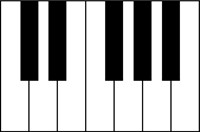 played on the keyboard. What you see is what keys you press. You’ll find these in a lot of chord encyclopedias and some course materials.
played on the keyboard. What you see is what keys you press. You’ll find these in a lot of chord encyclopedias and some course materials.
They don’t show the rhythm of notes and chords but it’s a great start because you can add rhythms that you create as well as those you can decipher by ear.
A Visual Learning System
You need to know some fundamental aspects of piano playing so you can teach yourself how to learn to play piano at home. In order to do that, I’m going to use tools from the Color Score Visual Chord Learning System.
If you’re familiar with keyboard diagrams (called Keyshots) and some music note values, they’ll make more sense to you. These are color coded to provide more information about the music. But you don’t need know how it all works just to follow along with the keyboard diagrams. You’ll find it quite simple. Music is just a series of pitched sounds. These sounds can be melodic (played one note at a time), or they can be harmonic (played together as a chord). The pitched sounds that we hear in western music are represented on the piano in groups of 12 different notes. If you start on any note on the keyboard and count up or down, you’ll start over on the same note after counting to 12.
Music is just a series of pitched sounds. These sounds can be melodic (played one note at a time), or they can be harmonic (played together as a chord). The pitched sounds that we hear in western music are represented on the piano in groups of 12 different notes. If you start on any note on the keyboard and count up or down, you’ll start over on the same note after counting to 12.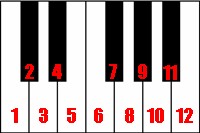 The only difference is the note will be at a higher or lower pitch. If you move up the keyboard (to your right), the pitches get higher. If you move down the keyboard (to your left), the pitches get lower.
The only difference is the note will be at a higher or lower pitch. If you move up the keyboard (to your right), the pitches get higher. If you move down the keyboard (to your left), the pitches get lower.
 You have 7 different white keys and 5 different black keys on the keyboard.
You have 7 different white keys and 5 different black keys on the keyboard.
 The notes in music are named after the first 7 letters of the alphabet:
The notes in music are named after the first 7 letters of the alphabet:

It just so happens that all of the white keys on the keyboard are named after these first 7 letters without any sharp or flat signs attached to them.

The easiest way to learn them is to use the black keys as a reference.

Look immediately to the left of any two black keys and you’ll find a C. They’re all over the keyboard.

Look immediately to the left of any three black keys and you’ll find an F. Again, they’re everywhere on the keyboard.

Now all you need to do is fill in the gap alphabetically to determine the rest of the notes.
Between C and F is D and E. Between F and C is G, A and B.

The black keys on the keyboard are referred to as accidentals. They’re also named after the 7 different notes of the alphabet but they’ll contain either a sharp or flat sign in front of them depending upon which key they’re being referenced in. Otherwise they’re enharmonic tones which means that they have 2 different note names by being referred to as a sharp and a flat.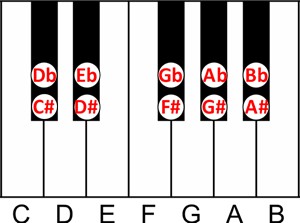 In order to keep things simple, we’re going to stay in the context of C Major for this article. But keep in mind that any chord or melody that can be played in the key of C Major can be played in any Major key of music.
In order to keep things simple, we’re going to stay in the context of C Major for this article. But keep in mind that any chord or melody that can be played in the key of C Major can be played in any Major key of music.
A key of music is simply a menu of 7 different notes in which you draw from to play a song or piece of music. The key of C Major consist of: C D E F G A B The way in which any key of music is structured is by whole steps and half steps. A half step is the distance from one key to the next without a key in between them. (you only have a crack in between)
The way in which any key of music is structured is by whole steps and half steps. A half step is the distance from one key to the next without a key in between them. (you only have a crack in between) A whole step is the distance from one key to the next with a key in between them.
A whole step is the distance from one key to the next with a key in between them.
 It may help you to remember this rhyme about whole steps and half steps:
It may help you to remember this rhyme about whole steps and half steps:
Half steps are from key to key with no key in the crack. Whole steps are from key to key with a middle key white or black.
So with that information about whole steps and half steps. You can find any Major key of music with this simple formula:
Whole-whole-half-whole-whole-whole

Getting back to melodies, it’s simple to see the key of C Major in action by looking at Keyshots of a single melody of “Amazing Grace”.
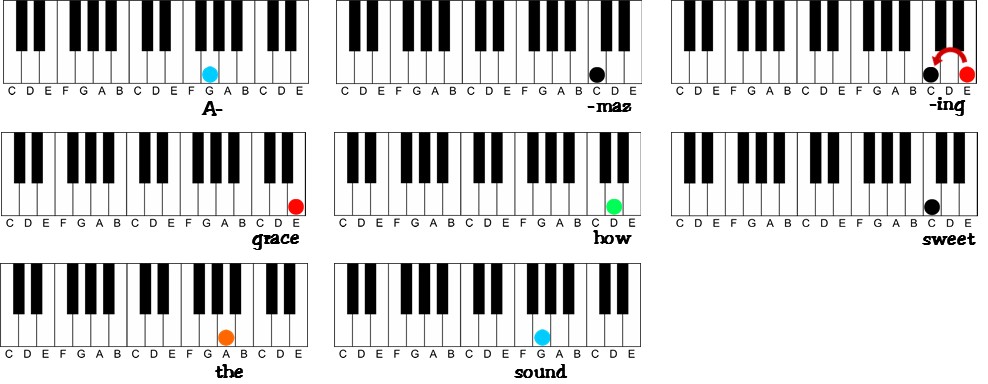
You can play the melody of virtually any popular song in the key of C Major just by playing single melody notes whether you read them on a piece of sheet music or hunt and peck them by trail and error.
It can be a fun exercise to find single note melodies without any kind of sheet music and it’s good for your musical 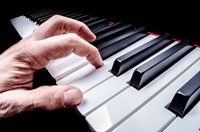 brain. However, if you don’t’ go beyond this level of piano playing, you’re going to get uninspired, bored and no will want to listen to you play.
brain. However, if you don’t’ go beyond this level of piano playing, you’re going to get uninspired, bored and no will want to listen to you play.
This is where harmony comes in. This is also known as playing chords. Any melody note in a key of music can be harmonized by one or more chords.
But the best way to approach harmony in any key of music is to utilize a group of 3 chords that are designed to harmonize any melody note in that key.
These are referred to as the primary chords. They’re very easy to learn and exist in every key of music. In order for me to help you understand primary chords, I need to illustrate and explain the number system.
Every note in the key of C Major that I covered earlier has a corresponding number. Each note in the key also has a corresponding chord that not only is referred to by its letter but also by its number.
So in the case of the key of C Major you have this numbered sequence: For now we’re going to focus only on the 1, 4 and 5:
For now we’re going to focus only on the 1, 4 and 5:

 As you can see this is the C, F and G Major chords.
As you can see this is the C, F and G Major chords.
These are the primary chords of C Major. Even though the chords would be different in a different key, they would still be the 1, 4, and 5 Chords.
As I stated before, the primary chords will harmonize any melody note in the key. Here’s the reason they function so well in doing so:
Again, here’s the 7 different notes in the key of C Major. If you analyze the primary chords and decipher the notes that’s in them, you’ll discover that can’t find one of them that doesn’t contain the notes that are in the key.
If you analyze the primary chords and decipher the notes that’s in them, you’ll discover that can’t find one of them that doesn’t contain the notes that are in the key.
The 1 Chord (C Major) contains: C E G
The 4 Chord (F Major) contains: F A C
The 5 Chord (G Major) contains: G B D
This means that any melody note can be harmonized by any primary chord that contains the same note.
If your melody note is:
C-harmonized by the 1 Chord (C Major) and 4 Chord ( F Major)
 D-harmonized by the 5 Chord (G Major)
D-harmonized by the 5 Chord (G Major) E-harmonized by the 1 Chord (C Major)
E-harmonized by the 1 Chord (C Major)  F -harmonized by the 4 Chord (F Major)
F -harmonized by the 4 Chord (F Major) G-harmonized by the 1 Chord (C Major) and 5 Chord (G Major)
G-harmonized by the 1 Chord (C Major) and 5 Chord (G Major)
 A-harmonized by the 4 Chord (F Major)
A-harmonized by the 4 Chord (F Major)
 B-harmonized by the 5 Chord (G Major)
B-harmonized by the 5 Chord (G Major) By following this simple outline that I just presented to you, you can literally harmonize thousands of popular songs. This really is the foundation of harmony. You can’t get any more fundamental that what I just covered.
By following this simple outline that I just presented to you, you can literally harmonize thousands of popular songs. This really is the foundation of harmony. You can’t get any more fundamental that what I just covered.
But learning to play in only one key isn’t satisfying. You can take this concept and apply it to every Major key of music. This will expand your song playing and harmonic possibilities even farther.
As with everything in music, there is no right or wrong but there is better or worse. In other words, everything is a 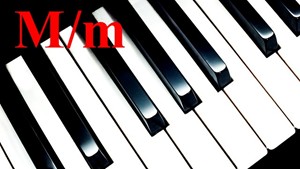 matter of taste. If you stay within the boundaries of primary chord harmony, you’ll find that it starts to become unsatisfying.
matter of taste. If you stay within the boundaries of primary chord harmony, you’ll find that it starts to become unsatisfying.
Why? Because there are certain elements missing that have always been present in the popular music you and I have been listening to our whole lives.
One of those elements is minor harmony. The primary chords are all Major. They have that happy sound associated with them. But playing them by themselves don’t sound as good unless they’re contrasted by minor chords.
It’s best to start with the secondary chords for minor harmony options. I won’t dive into them in this article, but I’ll direct you to this video tutorial that’s self explanatory if you would like to harmonize any melody with Major and minor harmonies the easiest way possible.
Beyond what I’ve just explained about primary chord harmony, learning the 12 Major Chords is among the most beneficial for anyone to teach themselves how to learn to play piano at home.
Because of the visual similarly of the Major chords, they can be learned much easier if you place them into four groups three. It’s far easier to learn four groups instead of twelve individuals.
I prefer to give each group a silly name that describe their appearance.
The Marshmallow Chords are white on the inside and white on the outside The Blackberry Jam Sandwich Chords are white on the outside and black on the inside
The Blackberry Jam Sandwich Chords are white on the outside and black on the inside The Oreo Cookie Chords are black on the outside and white on the inside
The Oreo Cookie Chords are black on the outside and white on the inside The Chocolate and Vanilla Chunk Chords are mixed up without any one having the same color pattern as another.
The Chocolate and Vanilla Chunk Chords are mixed up without any one having the same color pattern as another. Here’s a simple video tutorial to help you learn the 12 Major Chords as fast as possible.
Here’s a simple video tutorial to help you learn the 12 Major Chords as fast as possible.
Don’t underestimate the power of learning all 12 Major Chords in music. They’re the king of all chords in a way that leads to every other chord in music. The next most logical chord type is minor chords. In order to change any Major chord to minor, all that’s necessary is to lower the 3rd (middle note when the chord is in root position) a half step.
This means that in C Major, you just lower the E down to E flat. In G Major, lower the B down to B flat.
In G Major, lower the B down to B flat. In F Major lower the A down to A flat.
In F Major lower the A down to A flat.
You can create a minor chord from any Major chord by executing this movement and it doesn’t matter if the middle note or the note that is a half step down is on a black or a white key. It makes no difference.
There are two other types of triads in music that aren’t as common as Major and minor triads but fall within the category of the four different types of chords.
These would be diminished and augmented chords. These types of chords are more often used as transitionary chords meaning that you more often would play them as passing chords to get from one chord to another. The have an unstable sound that need to be resolved by other chords such as Major and minors. Just like minor triads, they’re derivatives of Major Chords.
In order to create an augmented chord from a Major chord, simply take the 5th (the top note of the chord when it is in root position) and raise it up a half step.
C Major to C Augmented F Major to F Augmented
F Major to F Augmented G Major to G Augmented
G Major to G Augmented Diminished chords are most easily created from minor chords. To create a diminished chord, simply lower the 5th (again the top note of the chord) a half step.
Diminished chords are most easily created from minor chords. To create a diminished chord, simply lower the 5th (again the top note of the chord) a half step.
C Minor to C Diminished F Minor to F Diminished
F Minor to F Diminished
G Minor to G Diminished
We could go much farther into chord theory such as extended chords and voicings but covering the four different types of chords (Major minor diminished augmented) is more than enough to get you started on how to learn to play piano at home.
Absent the melody while playing the piano, you’re just playing the accompaniment. This could be as simple as playing a series of chords by holding each one of them down until the next chord is played and repeating the pattern, or it could just be a simple rhythmic pulse of chords. Below is a chord progression of Keyshots that a very indicative of contemporary style music.
These chords are slightly more advanced than the chords that you’ve seen in this article so far. They’re in different positions called inversions and have the bass note in the left hand. This is essentially a voicing concept that fills out the chord. You’ll also notice that some of them have a note in the bass other than the root. These are called slash chords. Slash chords redefine a chord just by simply changing the bass note.
This video explains how to learn chord inversions.
Play these chords and hold each one of them for four beats until the next.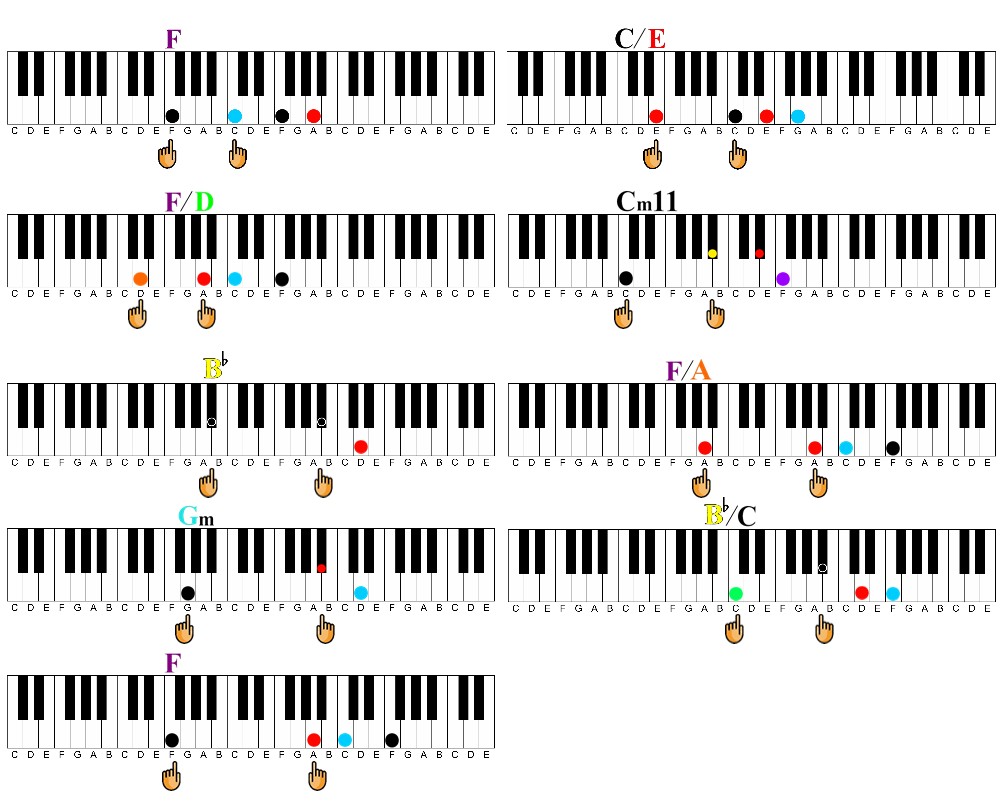 Now play them on each beat with a pulse of four beats and change to the next chord and repeat the pattern. As you noticed, there isn’t any melody being played. In this case, you or someone else would sing the melody or another instrument would play it if it was included at all.
Now play them on each beat with a pulse of four beats and change to the next chord and repeat the pattern. As you noticed, there isn’t any melody being played. In this case, you or someone else would sing the melody or another instrument would play it if it was included at all.
Accompaniments can be far more rhythmic than the examples I gave you, but these give you an idea on how simple they can be.
The Benefits Of Learning To Play Piano
 I’ve covered notes, keys of music, melodies, the four different types of chords and what accompaniment is, but there’s a few other things you should know about how to learn to play piano at home. One of those being the benefits of learning a music instrument.
I’ve covered notes, keys of music, melodies, the four different types of chords and what accompaniment is, but there’s a few other things you should know about how to learn to play piano at home. One of those being the benefits of learning a music instrument.
It’s quite different than many leisurely activities. You’re engaged in learning. This means that your using your brain. It’s quite natural for many adults who aren’t necessarily in a career where continuing education is a must, to simply complete repetitive tasks on a daily basis.
In the regular work environment of most people, they don’t receive those neurological benefits. This is extremely important for us as we grow older. There are many articles about the positive results of elderly Alzheimer’s and Parkinson’s patients who play piano. This article is about 82 year old Lucien Leinfelder who actually loses his severe Parkinson’s symptoms while playing the piano.
Also, according to a 2013 study by musician Linda Maguire who is also a neurologist, “Musical aptitude and music appreciation are two of the last remaining abilities in patients with Alzheimer’s disease.”
You’ll also find many articles about how a person’s aging brain will be in better shape if you take music lessons even in midlife or later years. You’ll find a National Geographic article on that very topic here.
Now that I’ve given you some very motivating practical reasons (did I mention how fun it is also?) for you to learn how to play piano at home, what are some ways to fit piano learning into your life?
How to Fit Piano Learning Into Your Life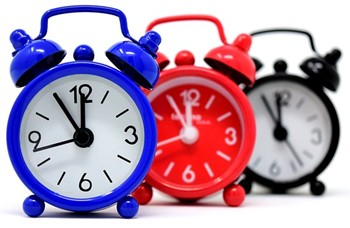
First, it’s about time. Everyone has time to do what they want to do. Not everyone takes the time to do what they really want to do.
So, if you’re an early bird, by all means, the early morning can be the perfect time to sit down and learn how to play piano at home. All is quiet in the world (for most of us) and the day hasn’t started yet.
It may very well be afternoon or evening that life slows down for you and you’re able to take advantage of that time. One common misconception is that in order for you to learn how to play piano at home, you must spend several hours a day slaving over the keys of a piano.
This is not true! If you’re a classically trained high level concert pianist and you must maintain your virtuosity at the utmost highest levels due to a hectic performance schedule, that may be the case. But this isn’t true at all for someone who wishes to learn piano at the level and genre that I’ve described.
In fact, learning how to play piano at home can be as simple as two 30 minute sessions a day weekly which after a year would add up to a total study time of 260 hours. That’s not counting any study time on the weekends. How well could play piano with amount of study time under your belt in just 12 months? Answer: You would be very pleased at the results.
 Many of us are surrounded by friends and family. (some of which we live with) So as not to be distracted away from piano study, you and they should have an understanding. You are dedicated to the amount of time that you need to study because you have a commitment.
Many of us are surrounded by friends and family. (some of which we live with) So as not to be distracted away from piano study, you and they should have an understanding. You are dedicated to the amount of time that you need to study because you have a commitment.
You would be surprised at how understanding and accepting friends and family can be when they know you have made a choice and a commitment to do something you believe in. They’ll back off from distracting you and respect you for making a decision to improve your life.
Having said all of that, those people who live with you may accept your commitment, but that doesn’t necessarily mean that they wish to hear you learn how to play piano in real time. If they’re not understanding about the process of how to learn to play piano at home, it very well may cause conflict.
Their desire for peace and quiet at the wrong time could be discouraging for you. This is going to lead us into the direction of discussing the options you may have as to where you conduct your piano studies.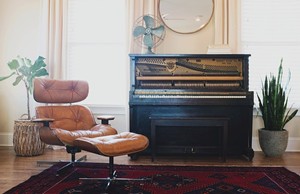
If you’re learning to play piano at home, is noise going to be an issue with your family/roommates? I should also mention neighbors because some of us live in close proximity as it relates to multi-user dwellings such as apartments.
Having your piano in the wrong spot such as next to a thin wall or window may not work out well if you decided to study at 3 o’clock in the morning . The point is to have a place to study your piano and at a time that works well for you and those around you.
By taking this into consideration, you can avoid problems later on that you didn’t know would pop up. (and yes I’ve had these issues so I don’t want them to take you by surprise)
How To Learn To Play Piano At Home | Instrument Options
 This leads me into instrument options. Before I get into these though, I want to acknowledge that you have digital keyboards and pianos as well as acoustic instruments as an option.
This leads me into instrument options. Before I get into these though, I want to acknowledge that you have digital keyboards and pianos as well as acoustic instruments as an option.
You can plug headphones into the former and it can be a huge problem solver. However, you should know that digital instruments are not totally silent.
There’s the sound of your fingers pressing down on the keys. How loud this is may be depend upon what type of key action there is. For example, hammer action keyboards can be quite noisy if someone in a bed next to you is trying to sleep. Long fingernails (I’m talking to you ladies) make this a lot nosier.
Now that I’ve cracked the egg on instrument options, what should you look for in a piano or keyboard. I have the tendency to use the word piano and keyboard interchangeably when I’m discussing playing the instrument.
But they’re actually two different types of keyboard instruments by definition. Before I dive into the differences, let me clue you in on what kind of keyboard instrument would be best for you to start with.
The answer is: Whatever type of keyboard instrument you have available to you. Please don’t think that you must purchase a shiny new instrument to get stared. No! You may already have a piano in the right location of your home with no concerns about needing anything else.
If not, I’ll ask you: Do you have a portable keyboard? It doesn’t have to be latest technology with all the features. 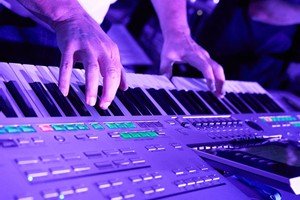
If you’re going to start with a portable keyboard, I suggest that it have at least 61 full size keys and some type of stand or table to place it on. (your back will eventually kill you if put it on your bed to study with) I wouldn’t recommend a small children’s keyboard such as the ones with miniature keys.
They’re just not large enough for adult hands and you’ll just get frustrated trying to actually play on them.
Some older keyboards may not have features such as a head phone jack and sustain pedal option, but that will be fine if that’s what you have access to. You don’t need a professional instrument right away to get started on how to learn to play piano at home.
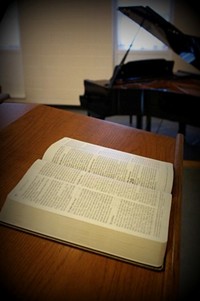 If you don’t have a piano or keyboard before you get started learning, do you have access to one? Maybe a friend or neighbor would let you borrow their portable keyboard or sell it to you. (I’m going to cover the keyboard market in just a moment)
If you don’t have a piano or keyboard before you get started learning, do you have access to one? Maybe a friend or neighbor would let you borrow their portable keyboard or sell it to you. (I’m going to cover the keyboard market in just a moment)
If you have access to a facility such as a church or theater that you can have some study time on, that may be an option for you. However, this article is all about how to learn to play piano at home and it would be best for you to eventually have your own instrument to study on. Outsourcing an instrument to study on will began get to old and doesn’t make for a permanent solution.
If the other options that I’ve mentioned aren’t available to you, you may be looking at buying an instrument. There are several options within this option. The first of these would be to consider buying a used instrument. The quickest way to do so is to find a seller in your local area.
You could locate a seller on Craigslist, Facebook Marketplace, Reverb (app for used instruments), universities who are upgrading, thrift stores, or check your local pawn shops or music stores.
Assuming that you have the time to search for and travel to a location to find an instrument that fits your needs, there’s certain types of instruments and features that I would recommend you look for since you’re going to actually be purchasing an instrument.
You’ll first need to determine what your budget is. For most people money is a significant factor so start with this first. I’ll have to tell you that you can find pianos and keyboards in very wide price ranges.
Acoustic Piano Options
I would like to start out with acoustic pianos since they may be the most obvious choice for a beginner to think about.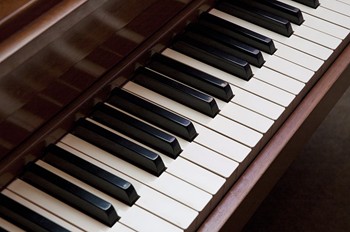 There’s no shortage of every kind of acoustic piano you can think of. There are upright, spinet, studio, and grand pianos.
There’s no shortage of every kind of acoustic piano you can think of. There are upright, spinet, studio, and grand pianos.
If you’re considering the purchase of an acoustic piano, you’ll have to determine if you have the space available to accommodate it (don’t forget what I covered earlier about other people in ear shot of your piano because you can’t use headphones with them).
Beyond having the space, you should determine the condition of the acoustic piano. In spite of what most people think, acoustic pianos are not made to last forever. Most people that have them in their home treat them as if they’re just another piece of furniture instead of a musical instrument. This means they’ve never had them tuned by a professional piano tuner.
Aside from dusting them and dressing them up with family photos, they typically don’t receive that much attention. Also, if they’ve every been placed in an area of high humidity such as a basement, the soundboard could be ruined and beyond repair. The strings inside a piano have hundreds of pounds tension on them and several years of neglect and or being kept in the wrong environment can render them unusable.
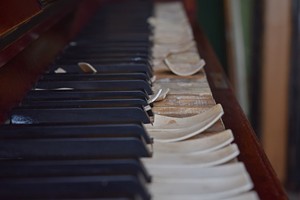 If you really want an acoustic piano, do your homework and find out what the real condition and value of the instrument is. Some people may find a piano that they think is perfect for them but just may need some restoration. In most cases a piano that is in need of being restored isn’t worth undertaking because the expense will usually cost more than purchasing a new acoustic piano.
If you really want an acoustic piano, do your homework and find out what the real condition and value of the instrument is. Some people may find a piano that they think is perfect for them but just may need some restoration. In most cases a piano that is in need of being restored isn’t worth undertaking because the expense will usually cost more than purchasing a new acoustic piano.
It’s not at all uncommon to for people to advertise an acoustic piano for free if you’ll just come and move it. It sounds like a great deal but beware that many people who make such an offer are doing so because they can’t sell the piano.
Often times, it’s not worth anything because of some of the reasons that I just mentioned. Since I brought up the subject of moving a piano, add this expense to the cost because you’ll most likely have to hire someone with the experience. Don’t hire amateurs to move a piano for you. It can be a disaster.
One more tip about used acoustic pianos, if you purchase from a dealer (many sell used and new) it will likely be in better shape than those from individuals. They’ll go over them with a fine toothed comb, make sure there’s no damage to them and that they’re in tune.
You will pay a higher price for this but you’re getting a better instrument. If you’re buying a new acoustic piano, a dealer can educate you about craftsmanship and the latest technology.
Digital Piano and Keyboard Options
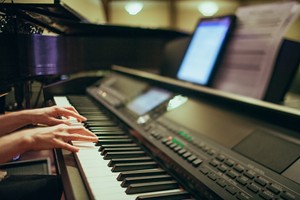 Digital pianos and keyboards are a more practical option for most people. Like acoustic pianos, they do come in all sizes from portable keyboards, stage pianos, digital console pianos and digital grand pianos.
Digital pianos and keyboards are a more practical option for most people. Like acoustic pianos, they do come in all sizes from portable keyboards, stage pianos, digital console pianos and digital grand pianos.
The one thing that they all have in common is the sound that they produce comes from digital technology known as sampling.
Without getting too technical, these sounds are just high quality recordings that are made from real acoustic instruments (and can be made from any instrument) that are played back when you press a key. Unlike acoustic instruments they never need tuning and they’re not affected by climate so it won’t make any difference whet you keep them.
The size consideration that I discussed earlier applies to the larger digital pianos. Moving doesn’t apply to them as much as acoustic instruments because they don’t weigh as much and can be disassembled, which will make it much easier and you don’t necessarily need professional movers. Shipping will be an issue because they’re still too heavy for simple package service would have to be shipped freight.
Portable keyboards and stage pianos are among the best options for price, space and portability. They can weigh 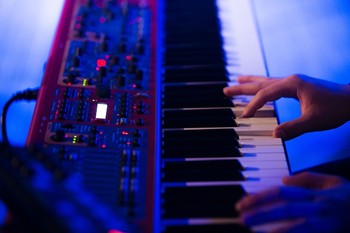 anywhere between 12 to 100 pounds. Older instruments tend to weigh more because as technology has improved, weight has been reduced.
anywhere between 12 to 100 pounds. Older instruments tend to weigh more because as technology has improved, weight has been reduced.
The closest you can get to the feel and realism of an acoustic piano is a digital piano. They’ll have 88 keys, a sustain pedal and hammer action keys (to simulate the hammers hitting strings).
Most pro instruments don’t have built in speakers so you’ll need headphones, monitors, or a keyboard amplifier for one of these. Lower end instruments have speakers built into them.
There can be other features for newer instruments but these that I just mentioned would be sufficient by themselves to help you get started on how to learn to play piano at home. In spite of piano players who insist that you should play only on an instrument that has hammer action weighted keys, it’s not wrong or a bad choice because you can (and most likely will) upgrade to a different instrument later on.
There’s essentially three types of key actions on portable keyboards available today.
1. Hammer Action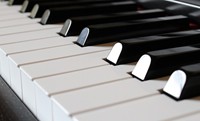
All of your digital pianos will have this type of action. This simulates the keyboard action of an acoustic piano. These are full size keys and replicate what you find on a real piano.
The keys are also weighted and if you learn how to play piano at home on these types of instruments, it will be an almost seamless transition to go from this to an actual acoustic piano. The quality and feel of the keys will vary from different manufacturers and models.
Most of these models have 88 keys but in the last several years manufacturers have produced models with less keys for portability such as 64 and 73 key models. This hammer action the best choice if you have the option.
2. Semi Weighted keys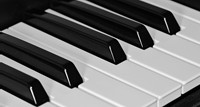
Semi weighted key action has a slightly weighted feel but it’s not as heavy as the hammer action models. The keys will be slightly narrower but they’re considered full size keys. Semi weighted key action requires a lighter touch than hammer action. The quality and feel will also vary from different manufacturers and models.
The number of keys will usually be no more than 76. The standard size is 61 keys. If you choose this option, try to at least find a keyboard with 73 keys or more because it allows you a greater range of notes to play with.
3. Synth Action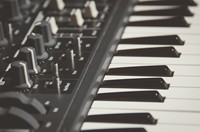
Synth action keys have a spongy non weighted feel to them and are among the most common key action of all portable keyboards. The keys themselves look identical to most semi weighted action keyboards and you wouldn’t be able to distinguish them from one another just by looking at them.
This would really be the last option if you had a choice. Synth action is more difficult to try to play on (at least like you would play a piano) and it will be the most noticeable transition to a regular piano than any other key action.
Options For Buying Keyboard Instruments Locally
 Just as you would with acoustic instruments, you’ll have to determine your budget and you also have the option of buying used digital instruments. Unlike buying an acoustic piano, digital keyboard instruments are more practical to purchase online due to much lower shipping costs. This opens up the marketplace to Ebay and online music retailers.
Just as you would with acoustic instruments, you’ll have to determine your budget and you also have the option of buying used digital instruments. Unlike buying an acoustic piano, digital keyboard instruments are more practical to purchase online due to much lower shipping costs. This opens up the marketplace to Ebay and online music retailers.
If you decide to buy locally from an individual, determine how far you want to actually travel to look at an instrument. Up to 40 miles would not be unreasonable but beyond that, it’s probably too far to go. (This does depend the population of the area you live in)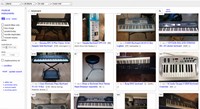
If it’s an online listing, it should include some reasonably good quality photos. It’s best if the seller includes any flaws or blemishes it may have. Stock photos (the ones manufacturers provide) are not acceptable.
You want to see the actual instrument. Some sellers wish to only communicate through text or email but it’s best to be able to talk to them personally. Ask them why they wish to sell the instrument. They’ll likely give you some insight and information about the instrument and instruments in general. Don’t try to negotiate price over the phone. This usually annoys sellers and just makes them think you’re not serious and want to low ball them.
Never send cash or wire money to a seller. People will often do this because they don’t want to miss out a great deal that a seller is offering them. Just don’t do it. You will get Scammed out of your money. When you do agree to meet a seller use common sense about safety by meeting in populated and safe area preferably with someone. (No meeting someone in a dark alley at midnight)
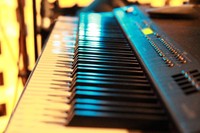 When you finally meet up with the seller, look the instrument over thoroughly. If it’s a digital instrument, be able to plug it in or put batteries in it (if applicable) to make sure it works. Make sure it’s the one in the pics you saw online.
When you finally meet up with the seller, look the instrument over thoroughly. If it’s a digital instrument, be able to plug it in or put batteries in it (if applicable) to make sure it works. Make sure it’s the one in the pics you saw online.
Look for anything that may give you pause about buying it. If you’re still interested in buying the instrument, do not make an offer on it until you go through the following process: Remind the seller of their asking price and ask them what they’re willing to take for it.
They almost always will come down from their asking price. If you make an offer before asking this, it could be more than they’re willing to take for it. So don’t cheat yourself. However, sometimes they won’t take less money. In this case, make a reasonable offer that’s fair to both of you.
There’s no guarantee that you’ll get the Instrument for less but people that sell used items are almost always willing to negotiate. If they’re not, be prepared to pay the asking price or walk away.
Once you make a deal, you’ll have to work the details about moving and transporting the instrument home. (Of course this only applies to large instruments such as acoustic or larger digital pianos)
Options For Buying Keyboard Instruments Online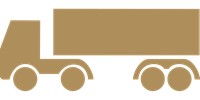
If you’re not enthused about hunting down used instruments in your local area, then you may be more comfortable about purchasing an instrument online. This is the most convenient and non hassle way to purchase an instrument.
After all, it’s delivered to your door without any leg work and I’ll admit that it saves time because I’ve purchased instruments locally and online.
I’m going to give some recommendations about instruments and accessories that are available to you at the time of this writing. They’re going to vary in cost and features so it’s ultimately up to you. I’m going to include only light weight portable instruments because of shipping considerations and price.
Items and accessories to help you get started on how to learn to play piano at home right now:
1. Yamaha NP32 76-Key Lightweight Portable Keyboard

This digital piano is as portable as you can get. It has 76 semi-weighted keys with a light touch response. It also has on board speakers and operates on batteries. A music stand is included. It has multiple voices including several pianos and organs. Unfortunately, it does not include a power supply but you can buy one for less than $20 if you don’t want to operate it with batteries all the time. You’ll find the best price on Amazon.
2. Yamaha P71 88-Key Weighted Action Digital Piano with Sustain Pedal, Black
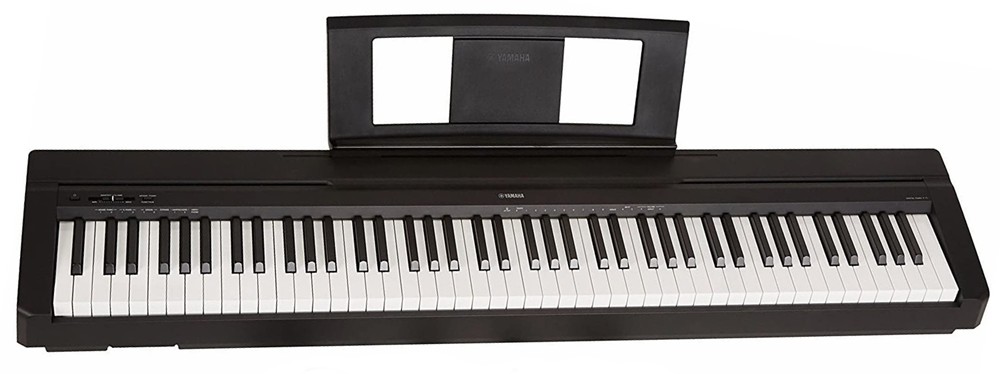 The Yamaha P17 is a significant step up from the NP32. It has 88 hammer action keys (as you would find on an acoustic piano), on board speakers, built-in Bluetooth wireless connectivity for using the piano with popular apps on your smartphone or tablet. It doesn’t operate on batteries so you would have use the included power supply in an outlet. If you want the best price check Amazon first.
The Yamaha P17 is a significant step up from the NP32. It has 88 hammer action keys (as you would find on an acoustic piano), on board speakers, built-in Bluetooth wireless connectivity for using the piano with popular apps on your smartphone or tablet. It doesn’t operate on batteries so you would have use the included power supply in an outlet. If you want the best price check Amazon first.
3. Roland FP-30 DIGITAL PIANO Black
The Roland FP-30x is an upgrade to the Fp-30. Although I haven’t had my hands on FP-30, the previous version is my favorite choice of these 3 digital pianos that I’ve shared with you. I’ve read the specs and watched video’s about it and it’s definitely and upgrade. It has PHA 4 (Roland’s proprietary design) hammer action keys. They also have an ivory look and feel as you would have on a grand piano. It does have powerful on board speakers and they sound amazing.
It has several different versions of pianos and other instruments. It includes a music stand. You can also connect this piano to your computer and other devices through USB and it even has Bluetooth connectivity (which you can use to play audio through the piano for accompaniment or learning wirelessly).
It doesn’t operate on batteries but includes a power supply. I can confidently say that after playing this piano, you would not need or want to upgrade to another piano for several years with this option.
Notice: At the time I’m writing this, this item is on back order so I didn’t include a link but if you can find one, it’s definitely the best choice.
4. Sony MDR7506 Professional Large Diaphragm Headphone
The Sony MDR 7506 headphones are not only professional grade headphones, they’re also very affordable. I used to think they’re wasn’t any difference between a $20 pair of headphones and anything that cost more than that. I hanged my mind after I’ve owned these.
The sound quality is excellent but that’s not the only thing that’s awesome about these headphones. The other great thing about them is that they’re so comfortable. They have this smooth springy feel that gently grips your head without fatigue.
Trust me, I wear headphones for hours at a time and comfort matters the longer you wear them. These over the ear headphones include a soft case and get this, they’re made to last so long that they actually sell replacement ear cups when these wear out.
These are not throw away headphones! You’ve probably noticed radio personalities wearing these because Sony has been producing these exact headphones for over 25 years.
5. Yamaha FC4A Assignable Piano Sustain Foot Pedal
Some piano manufacturers will include a pedal with the purchase of a keyboard, but it’s usually a square
switch style pedal as opposed to a piano style pedal. They have a tendency to move and slide around out from under your foot. You’ll discover that this is an annoyance (like I have) and you’ll want a more stable pedal.
The Yamaha FC4 Pedal is a piano style pedal with rubber grips on the bottom to help it stay in place while you’re playing. It’s solid and is designed to work with Yamaha digital pianos and keyboards. Pedals will still slide on carpet so my fix has always been fastening them down with Velcro to secure them and easily removethem when I need to.
6. Roland DP-10 Real-Feel Pedal with Non-Slip Rubber Plate
The Roland DP-10 pedal is a piano style pedal slightly different than the one I previously covered. It’s designed for Roland digital pianos and keyboards but like many of them are compatible with other manufacturers. It contains a non-slip rubber plate and the construction is solid.
It’s compatible with half damper capable keyboard (a realistic function of slightly sustaining the keys instead of all the way, just like an acoustic piano) I have several of these for my Roland pianos and keyboards and I’m very pleased. I still recommend using Velcro to fasten them to slip prone areas such as carpet.
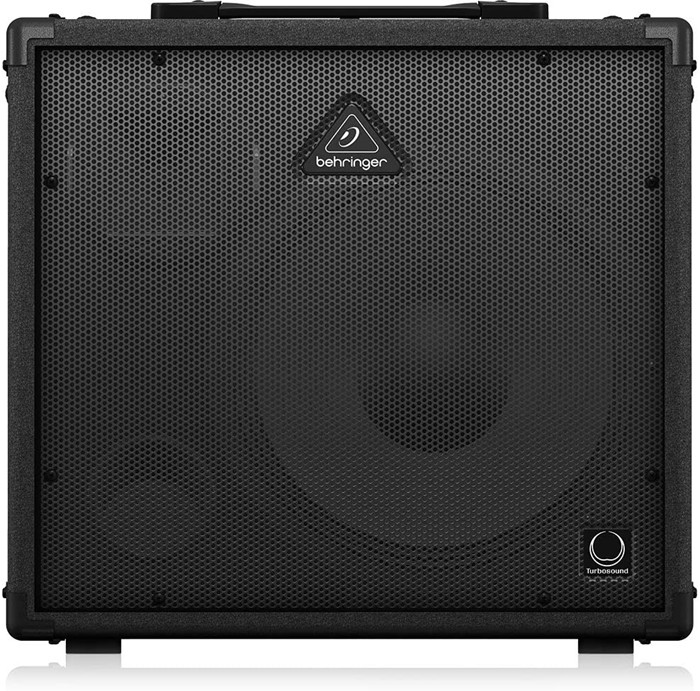
Even though the digital pianos that I’ve covered in this list have on board speakers, you may find one such as a pro model that doesn’t include them. Or you may very well want more amplification and have the ambience of a real acoustic piano through your process of how to learn to play piano at home.
Either way, you can’t go wrong with a quality amp that’s affordable and not over the top. The Behringer KXD12 fits right in to what I’ve just described. Just so you know, a keyboard amp is much different than a guitar amp so don’t consider using one of those even someone offers to give you one.
Digital pianos sound terrible through guitar amps because they can’t accommodate the dynamic range of a piano. This keyboard amp can double as a PA system because it not only has the input for your digital piano, you it has an input for a microphone and RCA inputs to plug in mp3 player for any audio you would like to play along with.
It has 45 watts of power (nice and loud if you need it). It weighs around 32 lbs. (not heavy) It also has a sub output (for a sub-woofer) if you want to add some more bass to it for an even more incredible sound. Here it is on Amazon if you want to check the price.
8. On Stage KS7350 Pro Heavy Duty Folding Z Keyboard Stand
I’ve owned all kinds of keyboard stands. Some digital pianos that are in the range of the ones I’ve talked about here will include a stand that’s specifically made for it. However, the On Stage KS7350 heavy duty stand will accommodate virtually any digital piano.
It’s rated up to 500 lbs and it’s adjustable from 24 to 38 inches high so you can sit or stand while playing your digital piano. It’s fully adjustable and that’s what I love about this keyboard stand. There are other options such as X stands and double X stands but this one is a better choice because it’s more sturdy and it’s just as portable.
Check out the Amazon price.
9.On Stage KT7800 Plus Padded Keyboard Bench
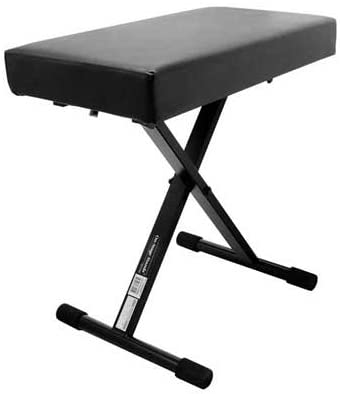
Next to headphones, another item that’s essential to being comfortable is what you’re sitting on. I’m going to cover not one but two options. The first one is the On Stage KT7800 adjustable padded bench. It’s an extra wide single seat with adjustable height. It has very thick padding and easily folds up to travel with or store. I’ve had one of these for over a decade and literally wore it out. So I can attest to its long lasting durability.
I’ve found the best price on Amazon.
10. Boss Office Products B315-BK Perfect Posture Delux Fabric Task Chair without Arms in Black
You may wonder why I added an office chair to this list. This isn’t an item that’s associated with piano or keyboards but it’s my personal preference to use and a swivel task chair instead of a bench at this point in my music studies. I know that it’s not for everyone but it’s comfortable and for me personally, it saves my back from strain and fatigue.
The Boss B315-BK is an adjustable mid back with tweed fabric. It has adjustable height and a maximum weight capacity of 250 lbs. It also comes in three colors. One thing that I want to point about it that this chair does not have arms and I purposely chose it for that reason. The chair arms seem to get in the way with your piano playing as I’ve experienced.
11. BEHRINGER EUROLIVE B1200D-PRO
I wasn’t going to cover this item at first. And don’t think it’s absolutely necessary to have for you to get started on how to learn to play piano at home, but it’s just too good not to mention. If you want the fullest sound experience from a digital piano, a sub woofer will create the low end frequency that an amp alone can’t give you.
The Behringer Eurolive B1200D-Pro is a 500 watt powered sub woofer with a steel grill to protect the cone and ergonomic handles for easier transport. It weighs approximately 43 lbs, has XLR inputs (the kind you have for microphones) and even includes a pole socket for mounting speakers with commercial speaker poles.
Proceeding with how to learn to play piano at home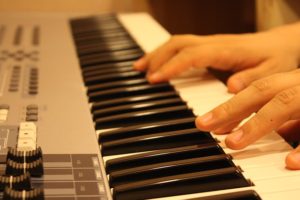
Now that I’ve covered some of the essential and not so essential items to help you get started, there’s some things you should know about how to learn to play piano at home. What I’m essentially talking about is the process.
When you know what to expect, it can help you through times that are more difficult than others and also times when you’re unsure what direction to go when you get stuck.
First of all, the study of piano playing is a daily endeavor. Notice I didn’t phrase my last statement by saying: You need to practice your piano every day. First of all, I hate the word practice and this statement alone has been responsible for many of aspiring piano players to get frustrated and just quit. I know this because I’m one of them.
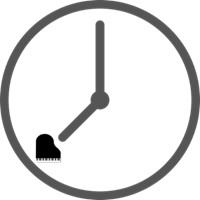 Don’t view learning how to play piano this way. You’re not practicing the piano. You’re playing the piano. When you change the way you look at things, the things you look at change. It’s not practice that makes the difference, it’s repetition. You may think that I’m just talking semantics here and if you think that’s the case, you need to change the way you look at things.
Don’t view learning how to play piano this way. You’re not practicing the piano. You’re playing the piano. When you change the way you look at things, the things you look at change. It’s not practice that makes the difference, it’s repetition. You may think that I’m just talking semantics here and if you think that’s the case, you need to change the way you look at things.
Earlier, I covered some specifics about fitting your piano study into your family/home life and I touched on the quantity of time you should spend. Beyond that, I want to give you some insight into how to fit it into your time schedule.
It will extremely helpful if you can execute you piano study at approximately the same time on a daily basis. I know from experience that if I don’t have a specific time (or time frame) every day, it tends to throw me off and I can’t get focused as much as if I’m on a regular schedule.
But, if you don’t have a set schedule and your day is played out more by a variety of times, that’s not going to break your piano study. I would say just do the best you can at developing a regular pattern and do your best to maintain it. When you have the desire, you’ll find a way and won’t be bothered by minor details or changes.
Learning how to play the piano is a journey. You should also have goals along the way. Those goals are going to 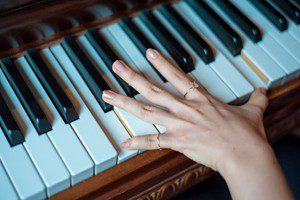 change as you progress. To begin with they may consist of simply acquiring certain musical skills such as learning all 12 Major Chords or identifying all 12 Major keys of music.
change as you progress. To begin with they may consist of simply acquiring certain musical skills such as learning all 12 Major Chords or identifying all 12 Major keys of music.
These are solid doable goals that will reward you over and over. It will also pave the way to bigger and better musical goals such as playing the songs that you’ve always wanted to play. I believe the most important concept that you should grasp is consistency.
You must stay engaged and that means even when you reach a plateau in learning. It’s guaranteed to happen. So you should expect it and know how to deal with it so you can break through until you reach the next one. Reaching a plateau (or getting stuck as some people call it) is perfectly normal and you should know that when you get to this point, you’re actually closer to a break through than without it.
There’s a lot I’ve shared with you in this article about how to learn to play piano at home. I truly hope you’ve taken some value away from it and you’ll get even more value if you subscribe to the free Color Notes Ezine that has articles, instructional guides and videos. I highly encourage you to visit this page to learn about the most visual way to play your piano or keyboard and sound like a professional without years of traditional piano lessons.
Until next time, Go Play!
Greg Lee
Latest posts by Greg Lee (see all)
- What is a minor/Major 7 Chord? - October 26, 2023
- 7 Chord Substitutions that Professionals Use - October 19, 2023
- 5 Simple Chord Tricks to Sound Amazing - October 5, 2023

